



















lands fish-bomber in jail | |
|
A LARGE amount of industrial explosive used in the illegal production of fish-bombs, was seized by Marine North Division police last October and a fisherman was arrested. Last month, the man was sentenced to 18 months' imprisonment by the court for possession of explosives. This is the first ever fish-bomb conviction under the Crimes Ordinance. The history of Chinese fishermen using home-made bombs to catch fish is hundreds of years old. In 1993, the Marine North Division seized 15 kilograms of explosives destined for fishbombing, with that figure soaring to 250 kg in 1997. The biggest seizure of fish-bombs occurred in 1996 when police raided an illegal fishing operation in Kat O and confiscated 225 kg - unfortunately no one was arrested. It raised the seizure figure for the year to 388 kg. Last August while on shore patrol duty, Marine North Division police discovered a large quantity of chemical explosives weighing 160 kg, along with detonators and fuses in blue plastic barrels hidden under rocks in Hoi Ha Wan, a remote beach in Sai Kung. But instead of seizing the find, police decided to lay an ambush for those involved in accumulating the substance, mounting land observation posts as well as tasking small boat and marine launch patrols. Then, at about 10:30am on 16 November, a boat was spotted approaching the scene, from which a man and a woman launched a sampan to land on the beach. Employing a video camera to record the male suspect taking a pack of explosive material from the hidden barrels, police officers approached the man, who quickly fled by jumping into the sea (ditching the pack of explosive material) and swimming back to the awaiting vessel. Marine Police intercepted the vessel and arrested him. |
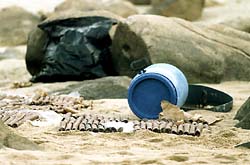 These chemical explosives, along with detonators and fuses in blue plastic barrels hidden under rocks in Hoi Ha Wan, helped Marine North Division police win the first ever fish bomb conviction under the Crimes Ordinance
|
|
"Police can use the Agriculture Ordinance, the Dangerous Goods Ordinance or the more severely penalising Crimes Ordinance to prosecute an offender. Because of the large amount of explosives seized in this operation, we were able to charge the offender under the Crimes Ordinance leading to his 18-month imprisonment," said ADVC Marine North Division, CIP Lai Yuk-wah. "Before removal, the seizure was examined at the scene by experts from the Explosive Ordnance Disposal Bureau." In addition to ongoing seminars jointly organised by Police and the Agriculture and Fisheries Department on the dangers of fish-bombing, DVC Marine North Superintendent Pong Wai-lung and his officers went to Kat O and Tap Mun following the man's conviction last month, to reason with fishermen and to distribute leaflets dissuading them from making bombs to catch fish. Successful prosecutions depend on enhanced communication with fishermen - especially the law-abiding ones who don't concoct fish-bombs. Not an easy task. "Using fish-bombs in these areas of the territory is a very old tradition that is difficult to change, and hard to convict because offenders can easily destroy the evidence," said CIP Lai. "Before the landmark criminal conviction, most fishermen there would never have imagined that processing a fish-bomb could land them in jail. In fact, most of the fishermen believe that no harm can come of it. So we have to change that way of thinking. Apart from educating fishermen on the danger posed to themselves, others and the environment by bombing, we also try to make them aware that the explosive (especially if stolen) can be used in a much more criminal way." "We also produced a video and powerpoint presentation to enhance the training of officers in Marine North, East and West Divisions," he added. Producer of the video, Inspector Tse Chun-nam cites greed and saving money as the logic behind fish-bombing: "The cost of using fish-bombs is relatively low. Bombed fishes and their pieces are then chopped up into little bits and sold to fish farmers." | |
for Emergency Units | |
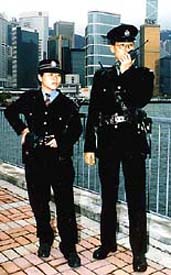 New hand-held and mobile radio equipment has greatly enhanced the operational efficiency, movement and mobility of EU officers 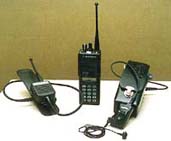 |
THE replacement of new hand-held and mobile radio equipment used by Emergency Units (EUs) has greatly enhanced the operational efficiency, movement and mobility of EU officers. Compact is the word to describe the new hand-held radio. It has accommodated a considerable increase in the number of channels with smaller size and lighter weight. Furthermore, the radio range has increased. This is attributable to the improvement in micro processor control and micro electronics advancement which has enabled the reduction in size and weight of radios. Moreover, there are two more pieces of equipment in the new radio system: the mobile radio and audio gear. Mobile radios are to be installed in EU vehicles enabling company fleet radio communications under convoy, and to facilitate company and platoon headquarters as and when required. Audio gear such as earpieces and throat microphones, both covert and overt types, are to be attached to the hand-held radio. The replacement of new radio equipment has not only enhanced intra-company communication in EU companies but also with the PTU companies. This new equipment is also fully compatible and inter-workable between the EU and PTU companies. |
|
The provision of this new radio equipment also allows EU officers to communicate with the beat radio system, a significant upgrading of the Force's communication system. With regard to the training of users, the supplier, comprising experienced engineers, provided training courses to EU officers on a "train-the-trainer" basis. They were fully briefed on the operational procedures of the system before it went into use. The radio project was implemented by the Communications Branch as continuous improvement and technical support to the Force's communications, and the project cost $9.6 million. | |
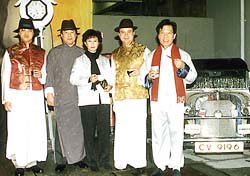
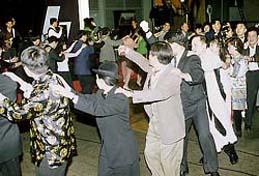
| |
|
"SHANGHAI YESTERYEAR", the modern nostalgia party held by KW Regional Headquarters, ended with guests dancing to the romantic sound of rain and the soft rhythm of music. All in attendance recall the evening as one of the most unforgettable celebrations in a long time, what with the chat, delicious food, performers from various districts and, of course, the rain. The heavier it fell, the more the guests danced. This was the biggest outdoor dance party ever held in Kowloon West Region - and the only one accompanied by the beat of the rain. |

